An Optical Water Type-Based Deep Learning Framework for Enhanced Turbidity Estimation in Inland Waters from Sentinel-2 Imagery
Abstract
Highlights
- A novel framework that integrates the fuzzy c-means method with a weighted blending CNN-RF deep learning model for accurate turbidity estimation based on optical water types was effectively implemented and validated using Sentinel-2 data.
- The OWT-based deep learning model achieves robust and generalizable turbidity predictions with high accuracy and effectively retrieves turbidity to capture the continuous spatial distribution characteristics of inland waters.
- This study provides a practical and accurate method for facilitating the application of deep learning models based on the optical classification of inland waters in turbidity estimation.
- The validated framework and methods enhance the operational capabilities of remote sensing for water quality monitoring and provide algorithmic support for a more comprehensive understanding of aquatic environmental conditions and ecosystem dynamics.
Abstract
1. Introduction
2. Materials and Methods
2.1. Study Area
2.2. Data Acquisition and Processing
2.2.1. Field Survey and Laboratory Measurements
2.2.2. Sentinel-2 MSI Data Acquisition and Processing
2.3. Methodology
2.3.1. Fuzzy C-Means Algorithms for Optical Water Classification
2.3.2. Base Regressor Algorithms for Turbidity Estimation
2.3.3. Research Framework for Turbidity Estimation Based on the Proposed Models
- (1)
- Two types of datasets were generated by matching Sentinel-2 images with in situ points, comprising the point data with spectral reflectance and the two-dimensional image patches for constructing deep learning models.
- (2)
- The fuzzy c-means cluster method was applied to the point data with Sentinel-2 spectral reflectance for optical water classification. The FCM method automatically partitioned samples based on the similarity of spectral characteristics. After identifying the clusters, the spectral reflectance of cluster centroids and a matrix encompassing each data point’s membership grades were calculated for each cluster. The dominant OWT for each point was determined as the cluster with the highest membership value. Subsequently, two-dimensional image patches corresponding to the classified sample points were grouped according to their assigned OWTs and utilized to train distinct turbidity prediction models.
- (3)
- We combined the CNN model and RF algorithm to form the CNN-RF model, which was employed to predict the water turbidity based on OWTs. To balance model complexity and generalization, the CNN framework incorporated two identical convolutional blocks. Each block consisted of a convolutional layer, a batch normalization layer, a max-pooling layer, and a dropout layer. The convolutional layers in the first and second blocks used 32 and 64 filters, respectively, with a 3 × 3 window size to generate feature maps. These two blocks were followed by a flattening layer and a fully connected layer containing 128 neurons. During the convolutional process, the spatial and spectral features of the input images were extracted. Subsequently, the output of the fully connected layer was supplied as input to a random forest algorithm, which served as a regressor for predicting water turbidity.
- (4)
- The FCM algorithm was applied to classify the samples to be predicted into a specified number of OWTs, with each type assigned a corresponding membership value. Water turbidity was predicted using pre-trained CNN-RF models for each OWT, yielding turbidity estimates corresponding to each OWT. The Euclidean distance was employed to assess the similarity between the sample’s reflectance and the spectral centroid of each OWT. A smaller distance indicates a higher similarity, which leads to a higher membership value for that OWT. These membership values were subsequently used as weighting factors for the turbidity predictions generated by the respective CNN-RF models. The weighted sum of all OWT-based turbidity predictions generated the final blending result.
- (5)
- For the application of Sentinel-2 imagery in water type classification and turbidity mapping, the image spectra were used as input for the FCM and CNN-RF models. For water classification, each pixel was assigned to a specific water type based on the maximum membership grade, which was derived from membership functions that calculated the distance between the reflectance of individual pixels and the spectral centroids of the in situ measured data. For turbidity mapping, each classified pixel with membership grades was predicted by the OWT-based CNN-RF models, and the blending retrieval result was the weighted sum of all OWT-based turbidity predictions using membership values.
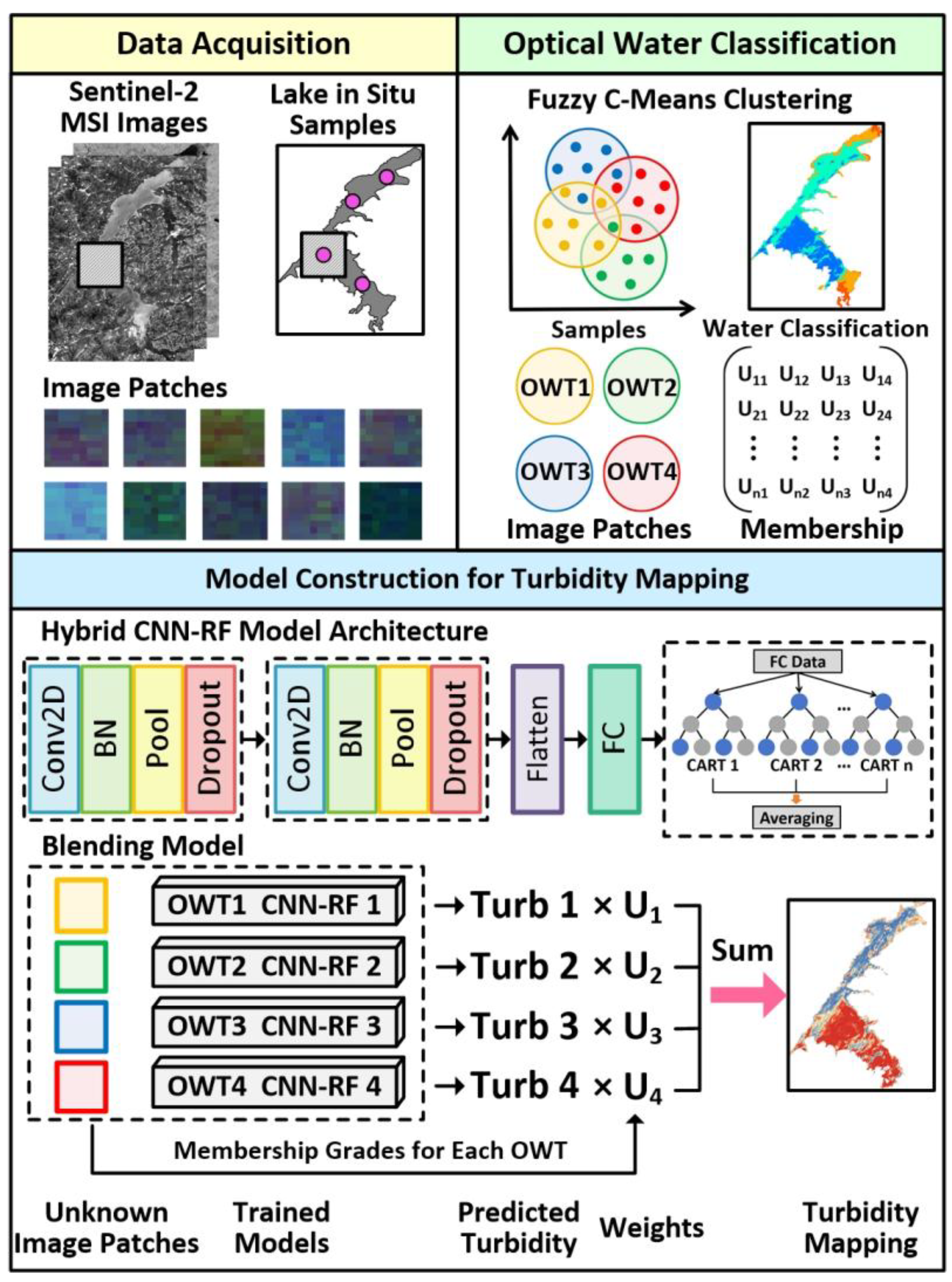
2.3.4. Model Accuracy Evaluation
3. Results
3.1. Spectral Fuzzy Clustering Using in Situ Data
3.2. Turbidity Estimation Model Construction and Performance Evaluation
3.2.1. Base Regressor Construction
3.2.2. Performance Evaluation of the Blending Estimation Model Based on OWTs
3.3. Sentinel-2 Image Application
3.3.1. Applicability Analysis of the OWT Classification
3.3.2. Applicability Analysis of the Turbidity Estimation
4. Discussion
4.1. Effectiveness of the FCM Method for OWT Classification
4.2. Performance of Blending CNN-RF Model
5. Conclusions
Author Contributions
Funding
Data Availability Statement
Acknowledgments
Conflicts of Interest
References
- Gleick, P.H. Global freshwater resources: Soft-path solutions for the 21st century. Science 2003, 302, 1524–1528. [Google Scholar] [CrossRef] [PubMed]
- Kuhn, C.; de Matos Valerio, A.; Ward, N.; Loken, L.; Sawakuchi, H.O.; Kampel, M.; Richey, J.; Stadler, P.; Crawford, J.; Striegl, R.; et al. Performance of Landsat-8 and Sentinel-2 surface reflectance products for river remote sensing retrievals of chlorophyll-a and turbidity. Remote Sens. Environ. 2019, 224, 104–118. [Google Scholar] [CrossRef]
- Deng, X.Y.; Song, C.Q.; Liu, K.; Ke, L.H.; Zhang, W.S.; Ma, R.H.; Zhu, J.Y.; Wu, Q.H. Remote sensing estimation of catchment-scale reservoir water impoundment in the upper yellow river and implications for river discharge alteration. J. Hydrol. 2020, 585, 124791. [Google Scholar] [CrossRef]
- Caballero, I.; Navarro, G.; Ruiz, J. Multi-platform assessment of turbidity plumes during dredging operations in a major estuarine system. Int. J. Appl. Earth Obs. 2018, 68, 31–41. [Google Scholar] [CrossRef]
- Carey, C.C.; Ibelings, B.W.; Hoffmann, E.P.; Hamilton, D.P.; Brookes, J.D. Eco-physiological adaptations that favour freshwater cyanobacteria in a changing climate. Water Res. 2012, 46, 1394–1407. [Google Scholar] [CrossRef]
- Pekel, J.F.; Cottam, A.; Gorelick, N.; Belward, A.S. High-resolution mapping of global surface water and its long-term changes. Nature 2016, 540, 418–422. [Google Scholar] [CrossRef] [PubMed]
- Akhtar, N.; Syakir Ishak, M.I.; Bhawani, S.A.; Umar, K. Various Natural and Anthropogenic Factors Responsible for Water Quality Degradation: A Review. Water 2021, 13, 2660. [Google Scholar] [CrossRef]
- Duan, W.; Takara, K.; He, B.; Luo, P.; Nover, D.; Yamashiki, Y. Spatial and temporal trends in estimates of nutrient and suspended sediment loads in the Ishikari River, Japan, 1985 to 2010. Sci. Total Environ. 2013, 461–462, 499–508. [Google Scholar] [CrossRef]
- Erena, M.; Domínguez, J.A.; Aguado-Giménez, F.; Soria, J.; García-Galiano, S. Monitoring Coastal Lagoon Water Quality through Remote Sensing: The Mar Menor as a Case Study. Water 2019, 11, 1468. [Google Scholar] [CrossRef]
- Gao, P.; Pasternack, G.B.; Bali, K.M.; Wallender, W.W. Estimating suspended sediment concentration using turbidity in an irrigation-dominated southeastern California watershed. J. Irrig. Drain. Eng. 2008, 134, 250–259. [Google Scholar] [CrossRef]
- Ayana, E. Determinants of Declining Water Quality; World Bank Group: Washington, DC, USA, 2019. [Google Scholar] [CrossRef]
- McCarthy, M.J.; Muller-Karger, F.E.; Otis, D.B.; Méndez-Lázaro, P. Impacts of 40 years of land cover change on water quality in Tampa Bay, Florida. Cogent Geosci. 2018, 4, 1422956. [Google Scholar] [CrossRef]
- Dogliotti, A.I.; Ruddick, K.G.; Nechad, B.; Doxaran, D.; Knaeps, E. A single algorithm to retrieve turbidity from remotely-sensed data in all coastal and estuarine waters. Remote Sens. Environ. 2015, 156, 157–168. [Google Scholar] [CrossRef]
- Li, S.J.; Kutser, T.; Song, K.S.; Liu, G.; Li, Y. Lake Turbidity Mapping Using an OWTs-bp Based Framework and Sentinel-2 Imagery. Remote Sens. 2023, 15, 2489. [Google Scholar] [CrossRef]
- Moore, G.K. Satellite remote sensing of water turbidity/Sonde de télémesure par satellite de la turbidité de l’eau. Hydrol. Sci. Bull. 2009, 25, 407–421. [Google Scholar] [CrossRef]
- Ouyang, T.P.; Zhu, Z.Y.; Kuang, Y.Q. Assessing impact of urbanization on river water quality in the Pearl River Delta Economic Zone, China. Environ. Monit. Assess. 2006, 120, 313–325. [Google Scholar] [CrossRef]
- Bustamante, J.; Pacios, F.; Diaz-Delgado, R.; Aragones, D. Predictive models of turbidity and water depth in the Doana marshes using Landsat TM and ETM+ images. J. Environ. Manag. 2009, 90, 2219–2225. [Google Scholar] [CrossRef]
- Palmer, S.C.; Kutser, T.; Hunter, P.D. Remote sensing of inland waters: Challenges, progress and future directions. Remote Sens. Environ. 2015, 157, 1–8. [Google Scholar] [CrossRef]
- Peterson, K.T.; Sagan, V.; Sloan, J.J. Deep learning-based water quality estimation and anomaly detection using Landsat-8/Sentinel-2 virtual constellation and cloud computing. GISci. Remote Sens. 2020, 57, 510–525. [Google Scholar] [CrossRef]
- Petus, C.; Chust, G.; Gohin, F.; Doxaran, D.; Froidefond, J.M.; Sagarminaga, Y. Estimating turbidity and total suspended matter in the Adour River plume (South Bay of Biscay) using MODIS 250-m imagery. Cont. Shelf Res. 2010, 30, 379–392. [Google Scholar] [CrossRef]
- Sebastiá-Frasquet, M.-T.; Aguilar-Maldonado, J.A.; Santamaría-Del-Ángel, E.; Estornell, J. Sentinel 2 Analysis of Turbidity Patterns in a Coastal Lagoon. Remote Sens. 2019, 11, 2926. [Google Scholar] [CrossRef]
- Cui, M.Y.; Sun, Y.H.; Huang, C.; Li, M.J. Water Turbidity Retrieval Based on UAV Hyperspectral Remote Sensing. Water 2022, 14, 128. [Google Scholar] [CrossRef]
- Wu, J.-L.; Ho, C.-R.; Huang, C.-C.; Srivastav, A.; Tzeng, J.-H.; Lin, Y.-T. Hyperspectral Sensing for Turbid Water Quality Monitoring in Freshwater Rivers: Empirical Relationship between Reflectance and Turbidity and Total Solids. Sensors 2014, 14, 22670–22688. [Google Scholar] [CrossRef]
- Yang, H.B.; Kong, J.L.; Hu, H.H.; Du, Y.; Gao, M.Y.; Chen, F. A Review of Remote Sensing for Water Quality Retrieval: Progress and Challenges. Remote Sens. 2022, 14, 1170. [Google Scholar] [CrossRef]
- Shen, X.; Feng, Q. Statistical model and estimation of inland riverine turbidity with Landsat 8 OLI images: A case study. Environ. Eng. Sci. 2018, 35, 132–140. [Google Scholar] [CrossRef]
- Zhang, Y.Z.; Pulliainen, J.T.; Koponen, S.S.; Hallikainen, M.T. Water quality retrievals from combined Landsat TM data and ERS-2 SAR data in the Gulf of Finland. IEEE T. Geosci. Remote 2003, 41, 622–629. [Google Scholar] [CrossRef]
- Silveira Kupssinskü, L.; Thomassim Guimarães, T.; Menezes de Souza, E.; Zanotta, D.C.; Roberto Veronez, M.; Gonzaga, L., Jr.; Mauad, F.F. A Method for Chlorophyll-a and Suspended Solids Prediction through Remote Sensing and Machine Learning. Sensors 2020, 20, 2125. [Google Scholar] [CrossRef] [PubMed]
- Sipelgas, L.; Raudsepp, U.; Kõuts, T. Operational monitoring of suspended matter distribution using MODIS images and numerical modelling. Adv. Space Res. 2006, 38, 2182–2188. [Google Scholar] [CrossRef]
- Song, K.S.; Wang, Q.; Liu, G.; Jacinthe, P.A.; Li, S.J.; Tao, H.; Du, Y.X.; Wen, Z.D.; Wang, X.; Guo, W.W.; et al. A unified model for high resolution mapping of global lake (>1 ha) clarity using Landsat imagery data. Sci. Total Environ. 2022, 810, 151188. [Google Scholar] [CrossRef]
- Tang, W.; Zhao, C.; Lin, J.; Jiao, C.; Zheng, G.; Zhu, J.; Pan, X.; Han, X. Improved Spectral Water Index Combined with Otsu Algorithm to Extract Muddy Coastline Data. Water 2022, 14, 855. [Google Scholar] [CrossRef]
- Uriarte, M.; Yackulic, C.B.; Lim, Y.; Arce-Nazario, J.A. Influence of land use on water quality in a tropical landscape: A multi-scale analysis. Landscape Ecol. 2011, 26, 1151–1164. [Google Scholar] [CrossRef] [PubMed]
- Zhang, Y.S.; Wu, L.; Ren, H.Z.; Deng, L.C.; Zhang, P.C. Retrieval of Water Quality Parameters from Hyperspectral Images Using Hybrid Bayesian Probabilistic Neural Network. Remote Sens. 2020, 12, 1567. [Google Scholar] [CrossRef]
- El Bilali, A.; Lamane, H.; Taleb, A.; Nafii, A. A framework based on multivariate distribution-based virtual sample generation and DNN for predicting water quality with small data. J. Cleaner Prod. 2022, 368, 133227. [Google Scholar] [CrossRef]
- Yang, H.B.; Du, Y.; Zhao, H.L.; Chen, F. Water Quality Chl-a Inversion Based on Spatio-Temporal Fusion and Convolutional Neural Network. Remote Sens. 2022, 14, 1267. [Google Scholar] [CrossRef]
- Pyo, J.; Duan, H.; Baek, S.; Kim, M.S.; Jeon, T.; Kwon, Y.S.; Lee, H.; Cho, K.H. A convolutional neural network regression for quantifying cyanobacteria using hyperspectral imagery. Remote Sens. Environ. 2019, 233, 111350. [Google Scholar] [CrossRef]
- Du, C.G.; Wang, Q.; Li, Y.M.; Lyu, H.; Zhu, L.; Zheng, Z.B.; Wen, S.; Liu, G.; Guo, Y.L. Estimation of total phosphorus concentration using a water classification method in inland water. Int. J. Appl. Earth Obs. Geoinf. 2018, 71, 29–42. [Google Scholar] [CrossRef]
- Cui, T.W.; Zhang, J.; Wang, K.; Wei, J.W.; Mu, B.; Ma, Y.; Zhu, J.H.; Liu, R.J.; Chen, X.Y. Remote sensing of chlorophyll a concentration in turbid coastal waters based on a global optical water classification system. ISPRS J. Photogramm. Remote Sens. 2020, 163, 187–201. [Google Scholar] [CrossRef]
- Bhuyan, M.; Jayaram, C.; Menon, N.N.; Joseph, K.A. Satellite-Based Study of Seasonal Variability in Water Quality Parameters in a Tropical Estuary along the Southwest Coast of India. J. Indian Soc. Remote Sens. 2020, 48, 1265–1276. [Google Scholar] [CrossRef]
- Menken, K.D.; Brezonik, P.L.; Bauer, M.E. Influence of Chlorophyll and Colored Dissolved Organic Matter (CDOM) on Lake Reflectance Spectra: Implications for Measuring Lake Properties by Remote Sensing. Lake Reserv. Manag. 2006, 22, 179–190. [Google Scholar] [CrossRef]
- Zhang, F.F.; Li, J.S.; Shen, Q.; Zhang, B.; Tian, L.Q.; Ye, H.P.; Wang, S.L.; Lu, Z.Y. A soft-classification-based chlorophyll-a estimation method using MERIS data in the highly turbid and eutrophic Taihu Lake. Int. J. Appl. Earth Obs. Geoinf. 2019, 74, 138–149. [Google Scholar] [CrossRef]
- Spyrakos, E.; O’Donnell, R.; Hunter, P.D.; Miller, C.; Scott, M.; Simis, S.G.H.; Neil, C.; Barbosa, C.C.F.; Binding, C.E.; Bradt, S.; et al. Optical types of inland and coastal waters. Limnol. Oceanogr. 2017, 63, 846–870. [Google Scholar] [CrossRef]
- Davies-Colley, R.J.; Smith, D.G. Turbidity suspeni)ed sediment, and water clarity: A review. J. Am. Water. Resour. As. 2001, 37, 1085–1101. [Google Scholar] [CrossRef]
- Bi, S.; Li, Y.M.; Xu, J.; Liu, G.; Song, K.S.; Mu, M.; Lyu, H.; Miao, S.; Xu, J.F. Optical classification of inland waters based on an improved Fuzzy C-Means method. Opt. Express 2019, 27, 34838–34856. [Google Scholar] [CrossRef] [PubMed]
- Sharif, S.M.; Kusin, F.M.; Asha’ari, Z.H.; Aris, A.Z. Characterization of Water Quality Conditions in the Klang River Basin, Malaysia Using Self Organizing Map and K-means Algorithm. Procedia Environ. Sci. 2015, 30, 73–78. [Google Scholar] [CrossRef]
- Moore, T.S.; Dowell, M.D.; Bradt, S.; Ruiz Verdu, A. An optical water type framework for selecting and blending retrievals from bio-optical algorithms in lakes and coastal waters. Remote Sens. Environ. 2014, 143, 97–111. [Google Scholar] [CrossRef] [PubMed]
- Ren, M.; Liu, P.Y.; Wang, Z.H.; Yi, J. A Self-Adaptive Fuzzyc-Means Algorithm for Determining the Optimal Number of Clusters. Comput. Intel. Neurosc. 2016, 2016, 2647389. [Google Scholar] [CrossRef]
- Garg, V.; Senthil Kumar, A.; Aggarwal, S.P.; Kumar, V.; Dhote, P.R.; Thakur, P.K.; Nikam, B.R.; Sambare, R.S.; Siddiqui, A.; Muduli, P.R.; et al. Spectral similarity approach for mapping turbidity of an inland waterbody. J. Hydrol. 2017, 550, 527–537. [Google Scholar] [CrossRef]
- Fang, C.; Song, C.C.; Wen, Z.D.; Liu, G.; Wang, X.D.; Li, S.J.; Shang, Y.X.; Tao, H.; Lyu, L.L.; Song, K.S. A novel chlorophyll-a retrieval model based on suspended particulate matter classification and different machine learning. Environ. Res. 2024, 240, 117430. [Google Scholar] [CrossRef]
- Ma, Y.; Song, K.S.; Wen, Z.D.; Liu, G.; Shang, Y.X.; Lyu, L.L.; Du, J.; Yang, Q.; Li, S.J.; Tao, H.; et al. Remote Sensing of Turbidity for Lakes in Northeast China Using Sentinel-2 Images with Machine Learning Algorithms. IEEE J. Sel. Top. Appl. Earth Obs. Remote Sens. 2021, 14, 9132–9146. [Google Scholar] [CrossRef]
- Havens, T.C.; Bezdek, J.C.; Leckie, C.; Hall, L.O.; Palaniswami, M. Fuzzy c-Means Algorithms for Very Large Data. IEEE Trans. Fuzzy Syst. 2012, 20, 1130–1146. [Google Scholar] [CrossRef]
- Chuang, K.-S.; Tzeng, H.-L.; Chen, S.; Wu, J.; Chen, T.-J. Fuzzy c-means clustering with spatial information for image segmentation. Comput. Med. Imag. Grap. 2006, 30, 9–15. [Google Scholar] [CrossRef]
- Han, J.; Park, D.-C.; Woo, D.-M.; Min, S.-Y. Comparison of Distance Measures on Fuzzyc-means Algorithm for Image Classification Problem. AASRI Procedia 2013, 4, 50–56. [Google Scholar] [CrossRef]
- Zhang, J.; Shen, L. An Improved Fuzzyc-Means Clustering Algorithm Based on Shadowed Sets and PSO. Comput. Intel. Neurosc. 2014, 2014, 368628. [Google Scholar] [CrossRef] [PubMed]
- Verma, R.K.; Tiwari, R.; Thakur, P.S. Partition Coefficient and Partition Entropy in Fuzzy C Means Clustering. J. Sci. Res. Rep. 2023, 29, 1–6. [Google Scholar] [CrossRef]
- Zhang, C.; Sargent, I.; Pan, X.; Li, H.P.; Gardiner, A.; Hare, J.; Atkinson, P.M. An object-based convolutional neural network (OCNN) for urban land use classification. Remote Sens. Environ. 2018, 216, 57–70. [Google Scholar] [CrossRef]
- Romero, A.; Gatta, C.; Camps-Valls, G. Unsupervised Deep Feature Extraction for Remote Sensing Image Classification. IEEE Trans. Geosci. Remote Sens. 2016, 54, 1349–1362. [Google Scholar] [CrossRef]
- Syariz, M.A.; Lin, C.-H.; Nguyen, M.V.; Jaelani, L.M.; Blanco, A.C. WaterNet: A Convolutional Neural Network for Chlorophyll-a Concentration Retrieval. Remote Sens. 2020, 12, 1966. [Google Scholar] [CrossRef]
- Pu, F.L.; Ding, C.J.; Chao, Z.Y.; Yu, Y.; Xu, X. Water-Quality Classification of Inland Lakes Using Landsat8 Images by Convolutional Neural Networks. Remote Sens. 2019, 11, 1674. [Google Scholar] [CrossRef]
- Friedman, J.H.; Meulman, J.J. Multiple additive regression trees with application in epidemiology. Stat. Med. 2003, 22, 1365–1381. [Google Scholar] [CrossRef]
- Alnahit, A.O.; Mishra, A.K.; Khan, A.A. Stream water quality prediction using boosted regression tree and random forest models. Stoch. Env. Res. Risk A. 2022, 36, 2661–2680. [Google Scholar] [CrossRef]
- Smola, A.J.; Schölkopf, B. A tutorial on support vector regression. Stat. Comput. 2004, 14, 199–222. [Google Scholar] [CrossRef]
- Wang, J.J.; Shi, P.; Jiang, P.; Hu, J.W.; Qu, S.M.; Chen, X.Y.; Chen, Y.B.; Dai, Y.Q.; Xiao, Z.W. Application of BP Neural Network Algorithm in Traditional Hydrological Model for Flood Forecasting. Water 2017, 9, 48. [Google Scholar] [CrossRef]
- Xie, D.; Qiu, Y.; Chen, X.; Zhao, Y.; Feng, Y. Evaluating Water Turbidity in Small Lakes Within the Taihu Lake Basin, Eastern China, Using Consumer-Grade UAV RGB Cameras. Drones 2024, 8, 710. [Google Scholar] [CrossRef]
- Li, Y.; Li, S.J.; Song, K.S.; Liu, G.; Wen, Z.D.; Fang, C.; Shang, Y.X.; Lyu, L.L.; Zhang, L.L. Sentinel-3 OLCI observations of Chinese lake turbidity using machine learning algorithms. J. Hydrol. 2023, 622, 129668. [Google Scholar] [CrossRef]
- Wang, Y.W.; Chen, J.; Cai, H.; Yu, Q.; Zhou, Z. Predicting water turbidity in a macro-tidal coastal bay using machine learning approaches. Estuar. Coast. Shelf Sci. 2021, 252, 107276. [Google Scholar] [CrossRef]
- Leggesse, E.S.; Zimale, F.A.; Sultan, D.; Enku, T.; Srinivasan, R.; Tilahun, S.A. Predicting Optical Water Quality Indicators from Remote Sensing Using Machine Learning Algorithms in Tropical Highlands of Ethiopia. Hydrology 2023, 10, 110. [Google Scholar] [CrossRef]
- Yang, W.L.; Fu, B.L.; Li, S.Z.; Lao, Z.N.; Deng, T.F.; He, W.; He, H.C.; Chen, Z.K. Monitoring multi-water quality of internationally important karst wetland through deep learning, multi-sensor and multi-platform remote sensing images: A case study of Guilin, China. Ecol. Indic. 2023, 154, 110755. [Google Scholar] [CrossRef]
- Zhang, J.W.; Meng, F.; Fu, P.J.; Jing, T.T.; Xu, J.; Yang, X.Y. Tracking changes in chlorophyll-a concentration and turbidity in Nansi Lake using Sentinel-2 imagery: A novel machine learning approach. Ecol. Inform. 2024, 81, 102597. [Google Scholar] [CrossRef]
- Singh, K.A.; Ryu, D.; Arora, M.; Tiwari, M.K.; Sahoo, B. Improving the accuracy of remotely sensed TSS and turbidity using quality enhanced water reflectance by a statistical resampling technique. Int. J. Appl. Earth Obs. Geoinf. 2025, 142, 104681. [Google Scholar] [CrossRef]
- Kong, Y.; Jimenez, K.; Lee, C.M.; Winter, S.; Summers-Evans, J.; Cao, A.; Menczer, M.; Han, R.; Mills, C.; McCarthy, S.; et al. Monitoring Coastal Water Turbidity Using Sentinel2—A Case Study in Los Angeles. Remote Sens. 2025, 17, 201. [Google Scholar] [CrossRef]
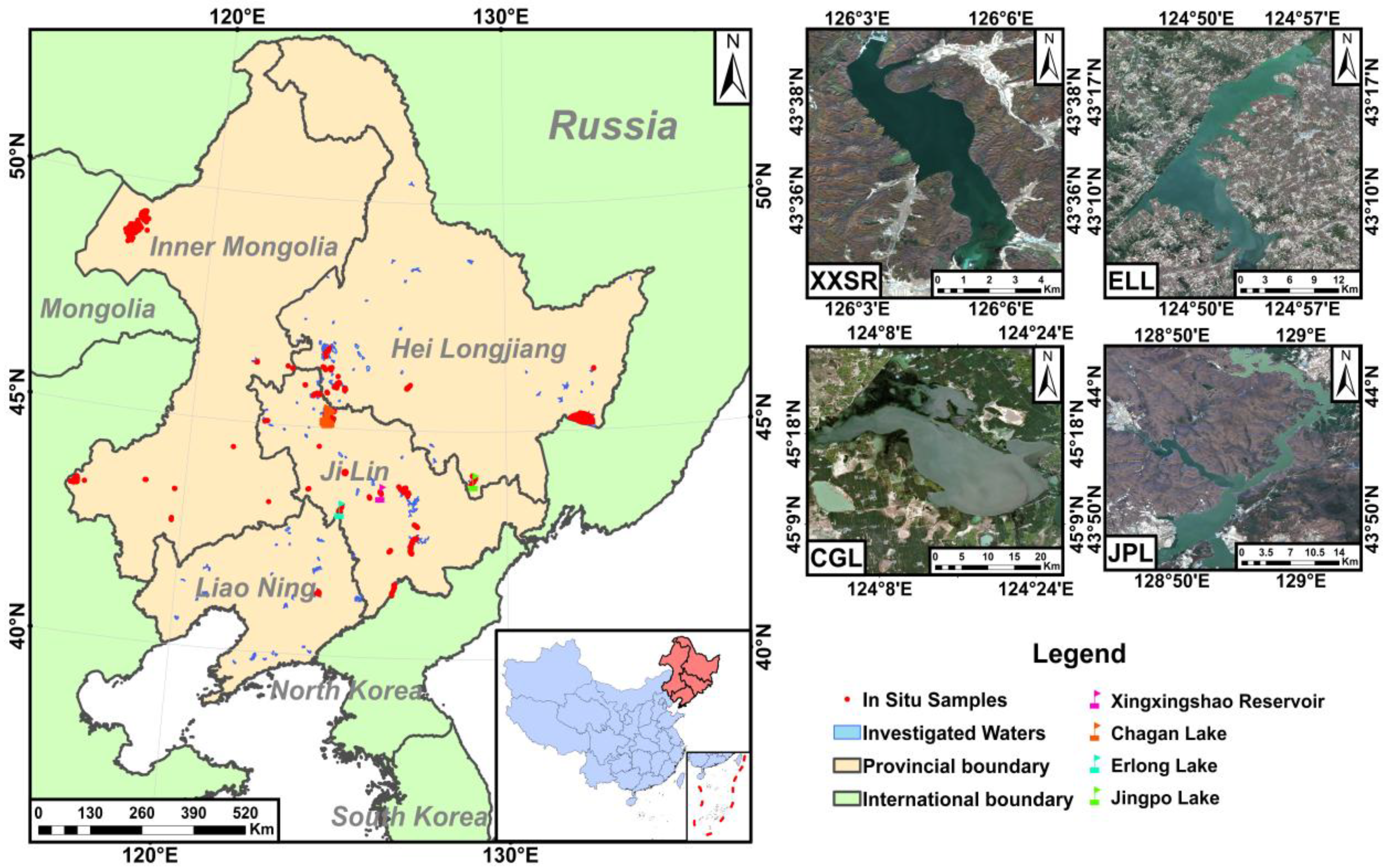
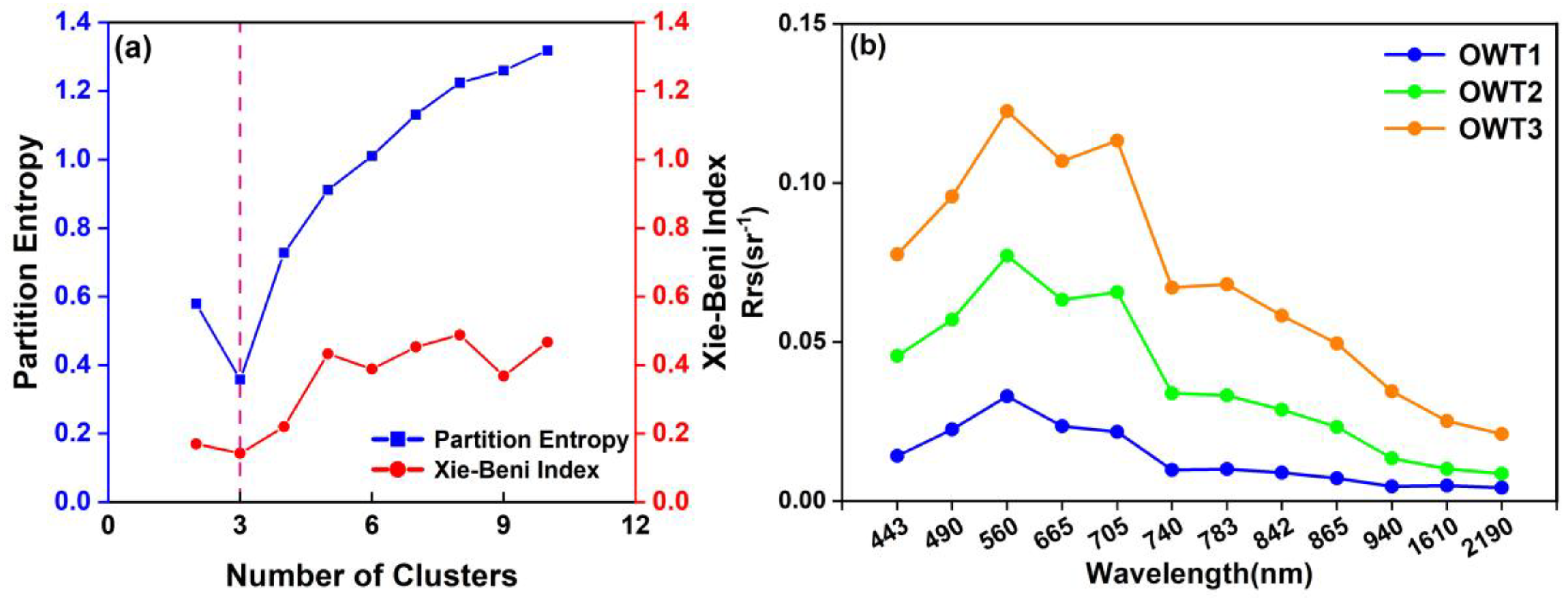

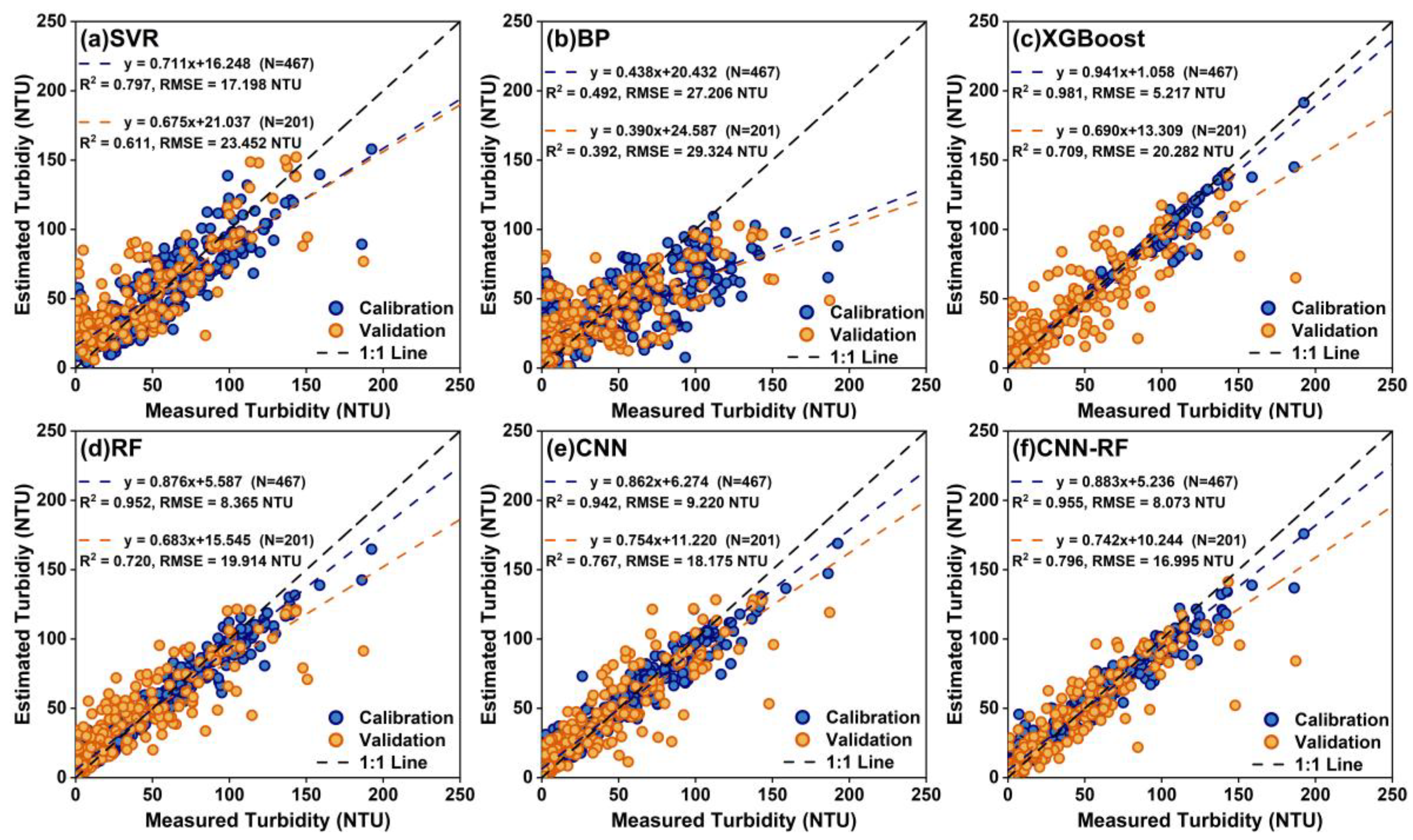

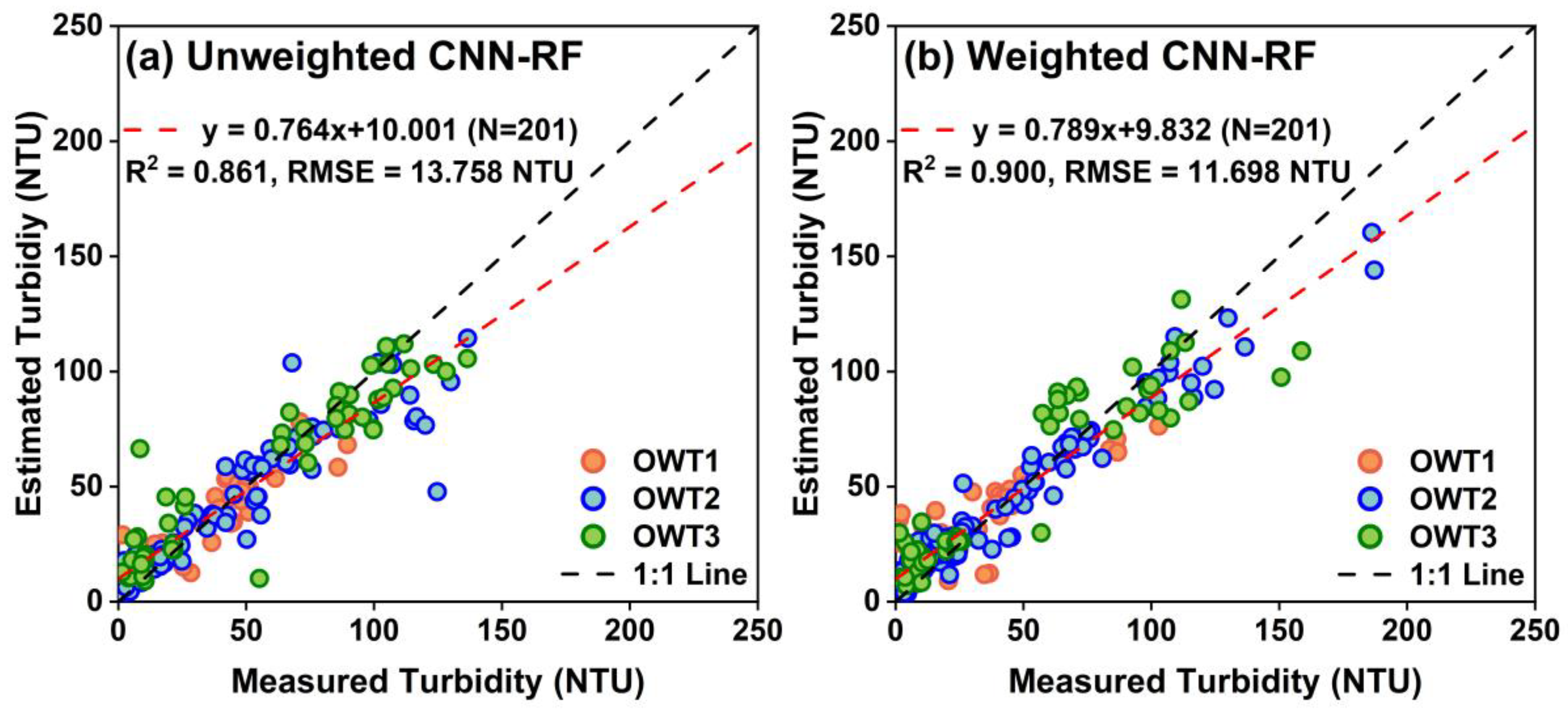
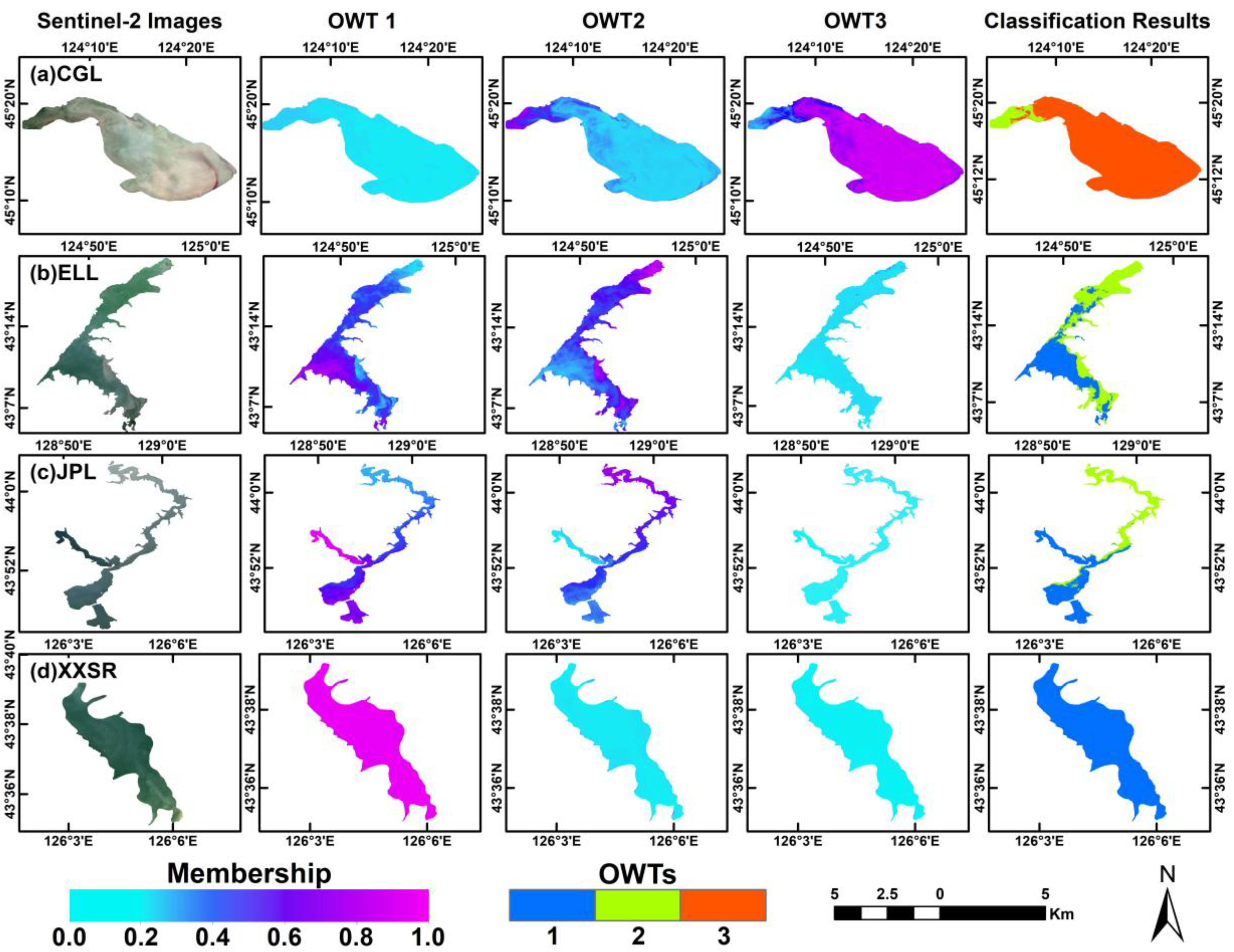
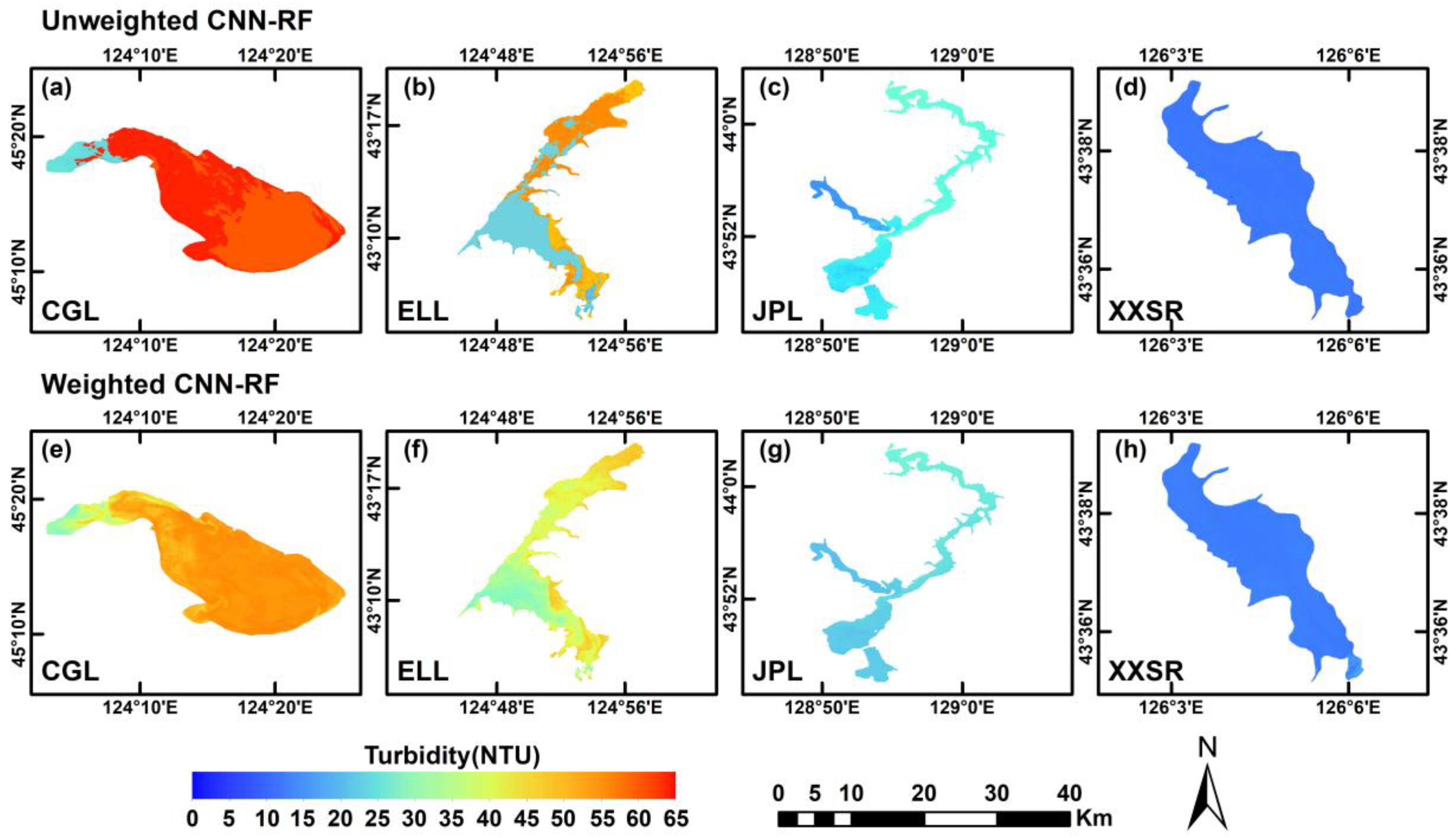
| Sampling Year | N | Mean (NTU) | S.D. (NTU) | Min. (NTU) | Max. (NTU) |
|---|---|---|---|---|---|
| 2018 | 188 | 36.051 | 31.686 | 0.532 | 136.597 |
| 2019 | 51 | 15.604 | 13.859 | 0.372 | 73.780 |
| 2021 | 111 | 83.737 | 39.281 | 4.303 | 192.486 |
| 2022 | 231 | 38.443 | 36.574 | 0.159 | 187.197 |
| 2023 | 19 | 57.756 | 19.409 | 25.838 | 102.843 |
| 2024 | 68 | 20.475 | 10.698 | 7.821 | 67.077 |
| Total | 668 | 42.271 | 38.026 | 0.159 | 192.486 |
| OWTs | Statistics | Turbidity (NTU) | Chla (μg/L) | TSM (mg/L) |
|---|---|---|---|---|
| 1 | Min | 0.159 | 0.474 | 0.727 |
| Max | 102.843 | 47.383 | 54.500 | |
| STD | 26.630 | 9.465 | 18.944 | |
| Mean | 27.975 | 8.807 | 25.271 | |
| 2 | Min | 0.372 | 0.085 | 0.571 |
| Max | 187.197 | 107.996 | 205.333 | |
| STD | 35.173 | 18.979 | 40.713 | |
| Mean | 42.010 | 12.360 | 33.735 | |
| 3 | Min | 1.055 | 0.061 | 0.857 |
| Max | 192.486 | 58.908 | 390.000 | |
| STD | 46.250 | 16.469 | 47.117 | |
| Mean | 57.214 | 15.590 | 50.607 |
| OWTs | N | R2 | RMSE (NTU) |
|---|---|---|---|
| 1 | 120 | 0.955 | 5.632 |
| 2 | 226 | 0.942 | 8.419 |
| 3 | 121 | 0.953 | 10.180 |
| References | N | Turbidity Range (NTU) | Best Model | R2 | RMSE (NTU) | |
|---|---|---|---|---|---|---|
| Ma et al. (2021) | [49] | 187 | 0.83–112.26 | GBDT | 0.88 | 9.90 |
| Wang et al. (2021) | [65] | 94 | 21.30–140.80 | ANN | 0.87 | 10.83 |
| Li et al. (2023a) | [14] | 484 | 0.00–282.74 | BP-TURB | 0.88 | 4.42 |
| Li et al. (2023b) | [64] | 1081 | 0.15–262.57 | RF | 0.92 | 12.65 |
| Leggesse et al. (2023) | [66] | 286 | 0.27–344.00 | RF | 0.80 | 7.82 |
| Yang et al. (2023) | [67] | 263 | 60.00–100.00 | GB | 0.75 | 0.51 |
| Zhang et al. (2024) | [68] | 360 | 2.87–31.43 | XGBoost | 0.79 | 2.18 |
| Singh et al. (2025) | [69] | 220 | 3.22–576.00 | RF | 0.77 | 33.16 |
| Kong et al. (2025) | [70] | 168 | 1.20–8.10 | RF | 0.63 | 1.58 |
| This study | - | 668 | 0.16–192.49 | CNN-RF | 0.90 | 11.70 |
Disclaimer/Publisher’s Note: The statements, opinions and data contained in all publications are solely those of the individual author(s) and contributor(s) and not of MDPI and/or the editor(s). MDPI and/or the editor(s) disclaim responsibility for any injury to people or property resulting from any ideas, methods, instructions or products referred to in the content. |
© 2025 by the authors. Licensee MDPI, Basel, Switzerland. This article is an open access article distributed under the terms and conditions of the Creative Commons Attribution (CC BY) license (https://creativecommons.org/licenses/by/4.0/).
Share and Cite
Ma, Y.; Chen, Q.; Song, K.; Yang, Q.; Zheng, Q.; Ma, Y. An Optical Water Type-Based Deep Learning Framework for Enhanced Turbidity Estimation in Inland Waters from Sentinel-2 Imagery. Sensors 2025, 25, 6483. https://doi.org/10.3390/s25206483
Ma Y, Chen Q, Song K, Yang Q, Zheng Q, Ma Y. An Optical Water Type-Based Deep Learning Framework for Enhanced Turbidity Estimation in Inland Waters from Sentinel-2 Imagery. Sensors. 2025; 25(20):6483. https://doi.org/10.3390/s25206483
Chicago/Turabian StyleMa, Yue, Qiuyue Chen, Kaishan Song, Qian Yang, Qiang Zheng, and Yongchao Ma. 2025. "An Optical Water Type-Based Deep Learning Framework for Enhanced Turbidity Estimation in Inland Waters from Sentinel-2 Imagery" Sensors 25, no. 20: 6483. https://doi.org/10.3390/s25206483
APA StyleMa, Y., Chen, Q., Song, K., Yang, Q., Zheng, Q., & Ma, Y. (2025). An Optical Water Type-Based Deep Learning Framework for Enhanced Turbidity Estimation in Inland Waters from Sentinel-2 Imagery. Sensors, 25(20), 6483. https://doi.org/10.3390/s25206483







